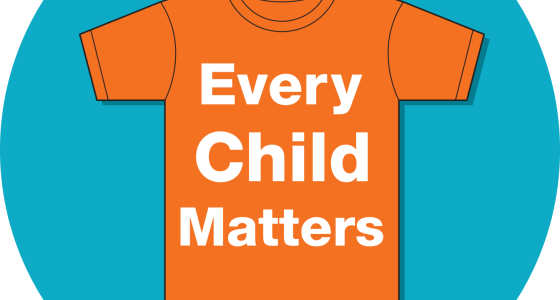Laurier University Library: Statement Recognizing the National Day for Truth and Reconciliation
Published:

The Laurier Library recognizes the first National Day for Truth and Reconciliation. We stand in support of and, are committed to, the process of reconciliation with Indigenous communities. We acknowledge that our work takes place on the Haldimand Tract, the traditional territory of the Neutral, Anishnaabe (pronounced Anish-nah-bay) and Haudenosaunee (pronounced Hoe-den-no-show-nee) peoples. This land is part of the Dish with One Spoon Treaty between the Haudenosaunee and Anishnaabe peoples and symbolizes the agreement to share, to protect our resources, and not to engage in conflict.
September 30th, 2021, marks the first National Day for Truth and Reconciliation, which the Government of Canada designated to honour First Nations, Inuit, and Métis survivors of the residential school system, their families, and communities, and to ensure the public commemoration of their history. The Laurier Library joins all of Canada in observing September 30th as a day to reflect upon this history and to encourage education about the residential school system and reconciliation.
September 30th is also Orange Shirt Day. The University has proposed several ways in which the Laurier community may wish to support the Woodland Cultural Centre, the site of the former Mohawk Institute. For more details, read the University's news announcement.
In recognition of the National Day for Truth and Reconciliation, the Laurier Library would like to highlight some key resources for the Laurier community to engage with.
Video resources
- Can-Core: Academic Video
- This resource is currently featuring a collection of videos in recognition of this National Day for Truth and Reconciliation on its launch page
- Truth, Reconciliation & Colonialism
- A playlist of 19 videos, such as The Grandfather Drum
- Treaties Recognition Playlist
- A playlist of 13 videos, such as The Impact of Colonialism in Canada
- National Film Board of Canada
- Includes a number of Indigenous films
- Bellrichard, Chantelle. 2018. #Beyond94 – Canada’s Cultural Genocide of Indigenous Peoples. Toronto: Canadian Broadcasting Corporation
- The Truth and Reconciliation Commission spoke to thousands of survivors and found that what took place in residential schools in Canada amounted to the cultural genocide of Indigenous Peoples. So, what changes have been made since then?
Electronic books
- Truth and Reconciliation Commission of Canada: Calls to Action. 2015. Truth and Reconciliation Commission of Canada.
- Honouring the Truth, Reconciling for the Future: Summary of the Final Report of the Truth and Reconciliation Commission of Canada. 2015. Truth and Reconciliation Commission of Canada.
- MacDonald, David Bruce. 2019. The Sleeping Giant Awakens : Genocide, Indian Residential Schools, and the Challenge of Conciliation. Toronto: University of Toronto Press.
- Miller, J. R. 2017. Residential Schools and Reconciliation : Canada Confronts Its History. Toronto, Ontario: University of Toronto Press.
- They Came for the Children Canada, Aboriginal Peoples, and Residential Schools. 2012. Winnipeg, Manitoba: Truth and Reconciliation Commission of Canada.
- McFarlane, Peter, and Nicole Schabus. 2017. Whose Land Is It Anyway? : A Manual for Decolonization British Columbia: Federation of Post-Secondary Educators of BC.
Print book
- Chrisjohn, Roland David., Sherri Lynn Young, and Michael. Maraun. 1997. The Circle Game : Shadows and Substance in the Indian Residential School Experience in Canada Penticton, BC: Theytus Books.
Articles
- James, Matt. 2017. “Changing the Subject: The TRC, Its National Events, and the Displacement of Substantive Reconciliation in Canadian Media Representations.” Journal of Canadian Studies 51 (2): 362–97.
- Styres, Sandra. 2021. “Contested Places: Addressing the TRC in Higher Education.” Research in Education. 110 (1): 3–20.
- Aitken, Avril, Mary Ellen Donnan, and Jean L Manore. 2021. “Responding to the Findings of Canada’s Truth and Reconciliation Commission: A Case Study of Barriers and Drivers for Change at a Small Undergraduate Institution.” The International Journal of Learning in Higher Education 28 (1): 97–111.
Image: Every Child Matters shirt, used with permission from the Orange Shirt Society
